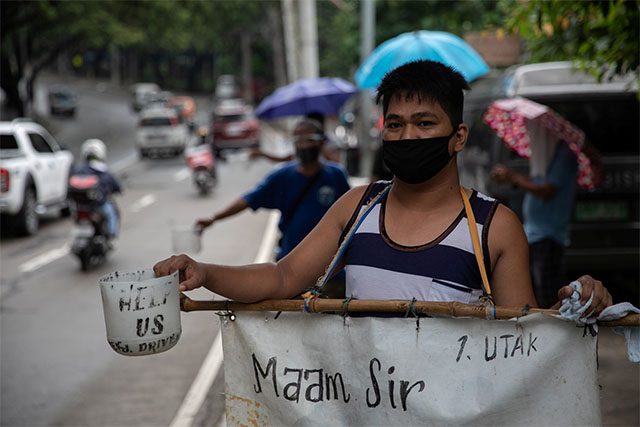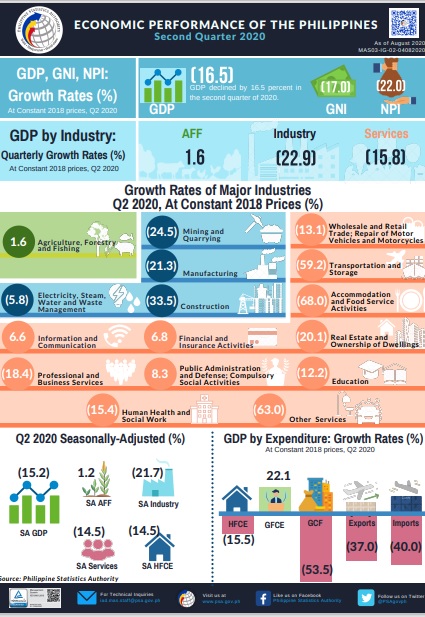
The Philippines has recorded the worst economic growth since the recession in 1981, according to the data released by Philippine Statistics Authority.
On Thursday, the PSA announced that the country’s gross domestic product (GDP) growth rate declined by 16.5% in the second quarter of 2020, which was the lowest recorded quarterly growth since 1981.
The Gross Domestic Product (GDP) growth rate declined by 16.5 percent in the second quarter of 2020, the lowest recorded quarterly growth starting 1981 series. #PHGDP
— PSAgovPH (@PSAgovph) August 6, 2020
This data is based on the year-on-year comparison from April to June, thereby officially marking the start of recession or the general decline of economic activity.
Reports said that this economic collapse was mainly the result of the stringent lockdown measures imposed across the country to supposedly prevent the spread of the COVID-19 in the past months.
These quarantine protocols shut down majority of businesses in various fields and halted mass transport across the country.
In layman’s terms, the country incurred a hefty P680 billion economic loss during the second quarter this year.
By the end of June, the value of financial losses reached P8.6 trillion.
During that month, the Department of Labor and Employment also announced that 2,068 companies reported closures, which consequently indicated over 69,000 workers unemployed amid the global health crisis.
Sad graphs of recession
Data analysts further explained the 2020 recession through graphs shared on the same day.
ABS-CBN’s data analyst Edson Guido shared a series of graphs showing comparisons of the Philippines’ GDP this year from the past 30 years as well as the country’s GDP from other countries in Southeast Asia.
BREAKING‼️
PH economy officially slips into recession for the 1st time in nearly 30 years amid the #COVID19 pandemic
– GDP fell in 2 consecutive quarters for the 1st time since 1991
– The 16.5% drop in Q2 was the worst contraction ever based on available data pic.twitter.com/vZMdxWMbu9
— Edson (@EdsonCGuido) August 6, 2020
In the first graph, Guido showed that this year, the country’s GDP dropped twice, which was the first time since 1991.
The second graph, meanwhile, showed that the Philippines’ GDP growth is the worst compared to Vietnam (0.4%), Indonesia (-5.3%) and Singapore (-12.3%).
He also showed specific data comparisons of the decline in the “demand-side growth” in the third graph.
Prior to such figures, Guido noted that the last biggest economic contraction of the Philippines was during the third quarter of 1985, which was during the dictatorship of late Ferdinand Marcos Sr.
Another analyst Dr. Peter Clayton from the University of the Philippines Pandemic Response Team shared his own plotted graphs that compared this year’s GDP growth to the past three years of President Rodrigo Duterte’s administration.
“With respect to 2018 constant prices GDP (subs for real GDP), the current economic recession might have just erased the gains of the Duterte administration,” Clayton said.
“The top three lines were 2019, 2018, & 2017 GDP; the unique downward slanting line is 2020 GDP, almost touches the 2016 2nd quarter,” he added.
With respect to 2018 constant prices GDP (subs for real GDP), the current economic recession might have just erased thegains of the Duterte admin.
The top 3 lines were 2019, 2018, & 2017 GDP; the unique downward slanting line is 2020 GDP, almost touches the 2016 2nd quarter. pic.twitter.com/4aqVfXnlSP
— Peter Cayton, the Stats Guy (@PJACaytonPhD) August 6, 2020
PSA also released an infographic of the country’s economic performance, wherein nearly all major industries had negative growth rates.

Only the following industries had a relatively positive outlook:
- Agriculture, forestry and fishing (1.6%)
- Information and communication (6.6 %)
- Financial and Insurance activities (6.8%)
- Public administration and defense: Compulsory social activities (8.3%)
In terms of expenditure, only the government’s expenditure grew by 22.1% while the rest—household, growth capital formation, imports and exports—fell.
What economists say
Prof. Ronald U. Mendoza, also the dean of Ateneo de Manila University’s School of Government, shared in a tweet that the shutdown of ABS-CBN with over 11,000 workers across the country and the passage of the controversial Anti-Terrorism Act of 2020 also contributed to such an economic state.
“Shutting down ABS-CBN and pushing a divisive anti-terror law really paid off,” he said.
16.5% GDP contraction and technical recession. Shutting down ABS-CBN and pushing a divisive anti-terror law really paid off.
— Ronald U. Mendoza (@ProfRUM) August 6, 2020
ABS-CBN’s radio, broadcast and digital services were permanently closed last July 10 after 70 lawmakers declined the network’s application for a fresh franchise to operate for the next 25 years.
The anti-terror bill, on the other hand, was signed into law last July 3. More than 20 petitions had since been filed before the Supreme Court to challenge its constitutionality.
Meanwhile, Justin Jimenez, an economist of Bloomberg, was quoted as saying that the projection for the Philippines’ economy might worsen in the next quarter, citing the re-imposition of the modified enhance community quarantine.
The MECQ started taking effect last August 4 and would last until August 18. The reimplementation of this quarantine phase which as the response to the distress call from health workers, covers Mega Manila.
“The plunge in Philippine GDP in 2Q likely marked a nadir for the economy, but more weakness lies ahead,” Jimenez said.
“Though economic activity has started to recover in 3Q with the reopening of the economy, a renewed surge in virus cases and the re-imposition of quarantine measures in parts of the country will be dragged on growth,” he added.
What gov’t officials say
Palace also expressed concern about this sharp economic decline and called on the Congress to fast-track the passage of the stimulus bills Bayanihan II or the Bayanihan to Recover As One and the Corporate Recovery and Tax Incentives for Enterprises Act or CREATE.
“We assure everyone that the government will continue working round the clock to strengthen our resilience and bring us back to the path of inclusive growth,” Roque said in a statement.









